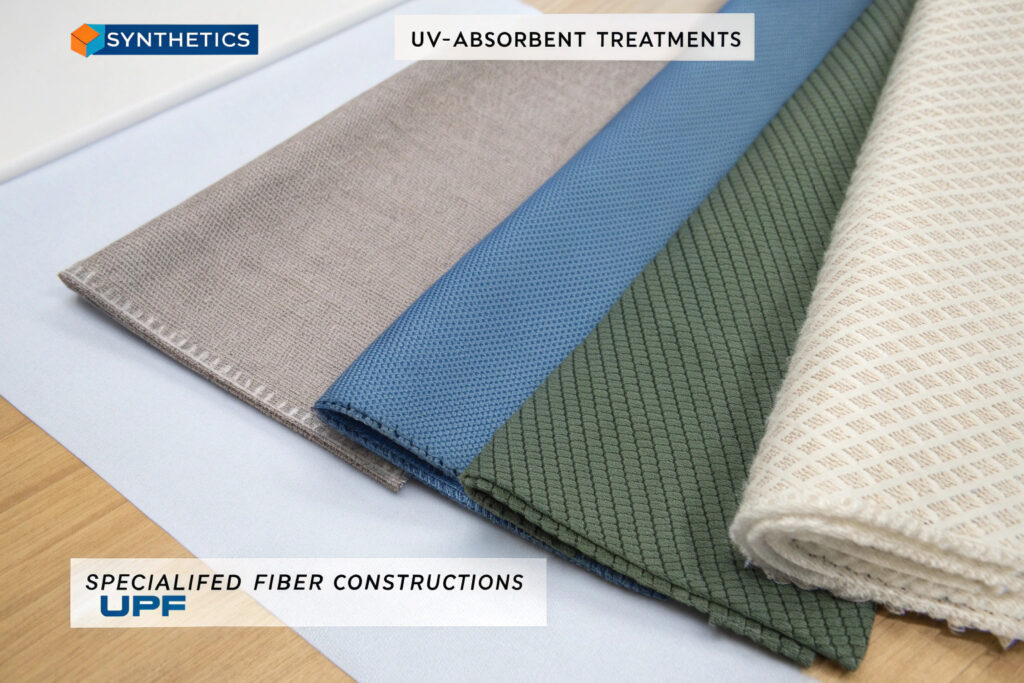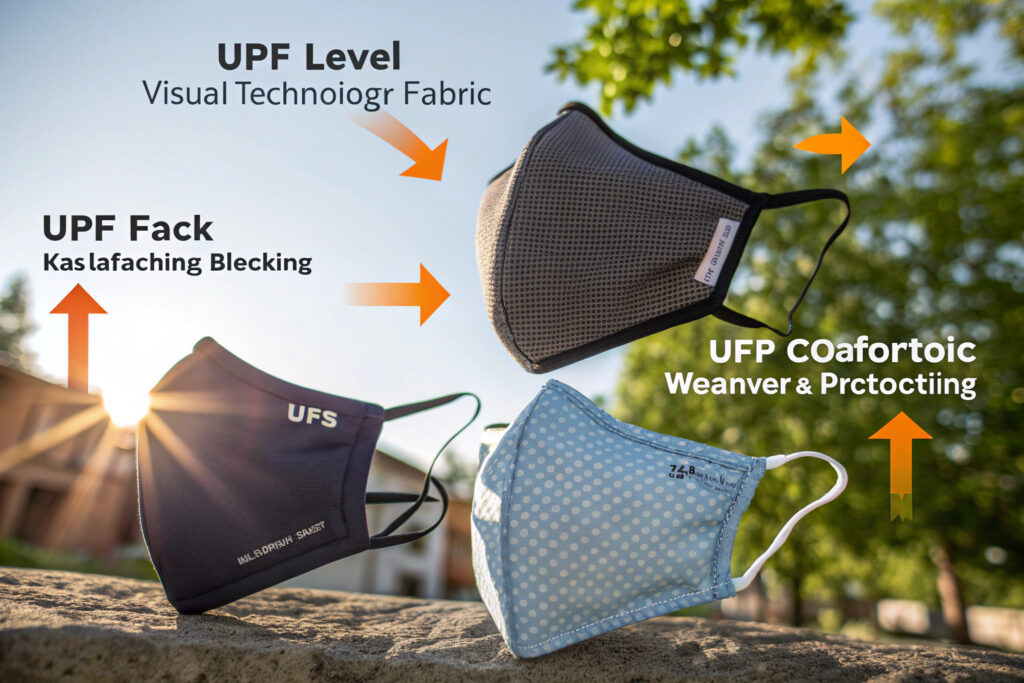As people spend more time outdoors while wearing face coverings, protection against ultraviolet radiation has emerged as a valuable secondary function for fabric masks. Standard masks offer minimal sun protection, but UPF (Ultraviolet Protection Factor) integrated designs provide measurable defense against UVA and UVB rays while maintaining breathability and comfort. Understanding the different approaches to incorporating sun protection helps brands develop masks that address multiple environmental concerns simultaneously.
The options for UPF-integrated sun-protective fabric masks include tightly woven synthetic fabrics, specially coated textiles, UV-absorbent fiber blends, multi-layer constructions with UV-blocking layers, and color-optimized fabrics that enhance natural protection. These approaches can achieve UPF ratings from 15-50+, blocking 93.3-98% of harmful UV radiation while maintaining the breathability and comfort required for extended wear.
The effectiveness of UPF integration depends on fiber content, fabric construction, color, finishing treatments, and overall mask design. Unlike sunscreen that can wear off, UPF fabrics provide consistent protection that doesn't diminish with extended wear, making them particularly valuable for outdoor workers, athletes, and anyone spending significant time in sunny conditions. Let's examine the specific options available and their relative advantages.
What Fabric Technologies Provide Built-in UPF Protection?
Several textile technologies can achieve significant UPF ratings without compromising mask functionality.

How do tightly woven synthetic fabrics achieve UPF?
Micro-denier polyester and nylon create dense fabric structures with naturally high UPF ratings due to their inherent ability to block UV radiation between closely spaced fibers. These technical fabrics typically achieve UPF 30-50+ (blocking 96.7-98% of UV) while remaining lightweight and breathable. The synthetic fibers themselves absorb some UV radiation, and the tight weaving prevents penetration between threads. Our performance masks using 75-denier polyester achieve UPF 45+ while maintaining excellent airflow for comfortable wear during activity.
What about UV-absorbent treatments and coatings?
Chemical finishes containing UV absorbers can be applied to natural fibers like cotton to enhance their inherent sun protection. These treatments typically use compounds like titanium dioxide or zinc oxide that absorb or scatter UV radiation. While effective, some treatments may wash out over time, reducing protection after 20-30 launderings. Our permanent UV treatments bond at the molecular level with cellulose fibers, maintaining UPF 30+ through 50+ washes without affecting breathability or hand feel.
What Construction Methods Enhance Sun Protection?
How masks are designed and constructed significantly impacts their overall UV protection effectiveness.

How does multi-layer construction improve UPF?
Strategic layer combinations can achieve higher UPF ratings than single layers of the same materials. While adding layers typically increases UPF, the relationship isn't simply additive—the combination creates a more complex pathway that UV radiation must navigate, increasing the likelihood of absorption or reflection. Our three-layer masks using UPF 15 outer layer, UPF 25 middle layer, and UPF 10 inner layer achieve cumulative UPF 40+ despite the individual layers having lower ratings.
What role does coverage and design play?
Extended coverage areas beyond standard mask dimensions provide more comprehensive protection, particularly for sensitive areas like the nose bridge, upper cheeks, and under the eyes where skin is thinner and more vulnerable to sun damage. Masks with wider side panels and integrated nose bridges prevent gaps where UV exposure can occur. Our sun-protective designs include 20-30% more coverage in critical areas while maintaining comfortable fit through strategic darting and contouring.
What Material Combinations Balance UPF and Breathability?
The challenge with sun-protective masks lies in maintaining adequate airflow while blocking harmful radiation.

How can natural-synthetic blends optimize performance?
Cotton-polyester blends (typically 60-70% polyester/30-40% cotton) leverage polyester's inherent UV resistance while maintaining cotton's comfort against the skin. The synthetic component provides the UPF foundation, while the natural fiber enhances moisture absorption and softness. Our most popular UPF mask uses a 65/35 polyester-cotton blend that achieves UPF 35 with better comfort ratings than 100% synthetic equivalents.
What about specialized sun-protective fabrics?
Technical fabrics developed for outdoor apparel offer advanced solutions with verified UPF ratings. These include solar-specific weaves like SolarWeave®, Coolibar® fabrics, and other proprietary textiles designed specifically for sun protection while maximizing breathability. While typically 25-40% more expensive than standard mask materials, these specialized fabrics provide documented performance and often include additional benefits like enhanced moisture-wicking. Our premium line uses these technical fabrics to achieve UPF 50+ protection.
What Certification and Testing Verifies UPF Claims?
Proper verification ensures UPF claims are accurate and reliable for consumers.

What standards govern UPF testing and claims?
AS/NZS 4399:1996 is the internationally recognized standard for measuring UPF in textiles, though newer standards like ISO 18058 are gaining acceptance. Testing involves exposing fabric samples to UV radiation and measuring transmission across the UV spectrum (280-400 nm). Reputable manufacturers provide test reports from accredited laboratories showing specific UPF ratings rather than generic "sun protective" claims. Our products undergo third-party testing at SGS-certified laboratories, with results available to clients.
How should UPF information be communicated to consumers?
Clear labeling with specific UPF ratings (e.g., "UPF 30," "UPF 50+") rather than vague terms like "sun protective" or "UV blocking" builds consumer trust. Labels should also indicate whether the rating applies to the fabric alone or the complete mask, as seams and design elements can affect overall protection. Our labeling includes both the tested UPF rating and a percentage of UV radiation blocked (e.g., "UPF 30 - Blocks 96.7% of UV").
What Are the Cost Implications of UPF Integration?
Adding legitimate sun protection affects product costing differently depending on the approach selected.

How much do UPF materials increase costs?
Basic UPF integration using tightly woven synthetic fabrics typically adds 10-20% to material costs compared to standard mask fabrics. Specialized sun-protective textiles increase costs by 25-50%, while proprietary technical fabrics with enhanced features may cost 50-100% more. Our analysis shows that the most cost-effective approach for achieving UPF 30+ uses optimized synthetic blends with minimal cost premium.
What about treatment and certification expenses?
UV-resistant treatments add $0.08-$0.15 per mask in chemical costs and application expenses. Third-party testing and certification typically represents a one-time cost of $1,200-$2,500 per fabric type, which becomes negligible at production scales above 10,000 units. Our clients typically amortize testing costs across multiple seasons or product lines to minimize per-unit impact.
Conclusion
UPF-integrated sun-protective fabric masks offer valuable additional functionality for outdoor use, with options ranging from cost-effective tightly woven synthetics to premium technical fabrics with maximum protection. The most successful implementations balance UPF performance with breathability, comfort, and cost considerations to create products that provide genuine value beyond standard masks. With proper testing and clear communication of protection levels, UPF integration represents a meaningful product differentiation in markets where consumers face significant sun exposure.
As awareness of sun protection grows and mask-wearing continues in outdoor settings, UPF functionality transitions from nice-to-have feature to legitimate performance advantage. Brands that invest in properly engineered sun-protective masks position themselves at the intersection of health protection and lifestyle functionality.
Ready to develop UPF-integrated sun-protective fabric masks for your market? Contact our Business Director, Elaine, at elaine@fumaoclothing.com to discuss our UPF fabric options and testing capabilities. We'll help you select the right approach for your target price points and performance requirements while ensuring accurate protection claims.


























